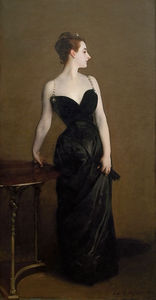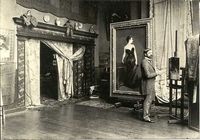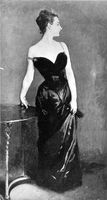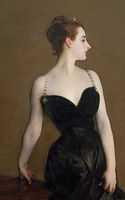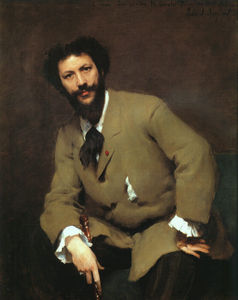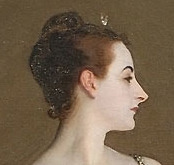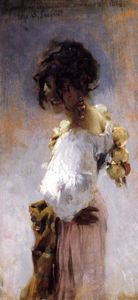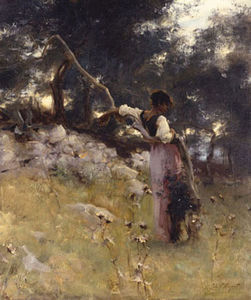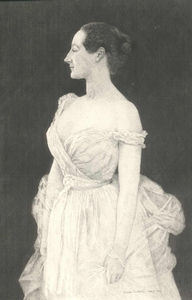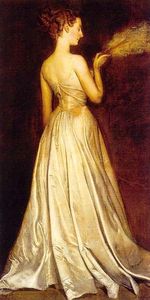Madame X
- Date of Creation:
- 1884
- Alternative Names:
- Madame Pierre Gautreau
- Height (cm):
- 208.60
- Length (cm):
- 109.90
- Medium:
- Oil
- Support:
- Canvas
- Subject:
- Figure
- Framed:
- Yes
- Art Movement:
- Realism
- Created by:
- Current Location:
- New York, New York
- Displayed at:
- Metropolitan Museum of Art
- Owner:
- Metropolitan Museum of Art
Madame X Story / Theme
Gautreau's beauty, provocative dress and studied indifference, along with her rumored affairs, made her the belle célèbre of Parisian society. Gautreau turned down many requests of this nature and it was a stroke of luck for Sargent that she finally consented two years later, after much pleading.
As was the case throughout most of his career, Sargent insisted on having control over his sitters' wardrobe. Sargent chose one of her more revealing, black gowns, which radiated sexuality and provided a dramatic contrast to the unnaturally pale skin for which she was known.
Sargent struggled with the painting at first. He had a hard time deciding on a pose, sketching her many different times and in many different positions: seated in a contorted pose, seated with her head raised, then lowered, even holding out a champagne glass. Finally, Sargent chose his decisive, ground-breaking pose: Amelies' body faces the viewer with her head turned in profile and arm twisted onto a supporting table.
Gautreau raved to her acquaintances about the painting- despite never having seen it in its finished form. The salon hardly opened before the picture was condemned for the sitters' "flagrant insufficiency" of clothing, the critique against its odd composition almost an afterthought. The Parisian public could not stop talking about Madame X - it was a scandal of epic proportions. Even before the first day of the exhibition had passed, Amelies' family was petitioning the Salon to take it down - a request it denied.
For fear of the family destroying the painting, Sargent took it down himself, returning it to his studio. There, in his one artistic moment of self-doubt, Sargent altered the womans' left strap so that it faced up-right as you see today, rather than being provocatively lowered.
This portrait ruined Sargents' promising career in Paris.
Madame X Inspirations for the Work
Amelie Gautreau had all of Paris talking the moment she debuted into Parisian society. Her unnaturally pale skin was rumored to be caused by ingesting small amounts of arsenic, which combined with the lavender powder she loved to put all over her body - including on the tips of her ears, gave her an unnatural glow. It was this glow that entranced Sargent - and which he would struggle to capture in the studio.
Sargents' inspiration was, in his own words, her "unpaintable beauty and hopeless laziness" which he captured in her languid body language and sensual but indifferent gaze. Perhaps this painting is so timeless because in it Sargent managed to capture the beauty of a woman whose, according to a contemporary of the period: "studied, indifferent, statuesque presence stopped parties, stopped traffic in the street."
At a little over seven feet tall, the portrait was larger than life and looked down at the viewer. Her shockingly low-cut dress (for the time period) predictably caused the huge scandal which partially accounts for the portraits' fame.
Sargent was also inspired by the brashness of his youth and his desire for artistic fame. While he drew on many of the influences that would play a role in his later work, Sargent daringly broke new artistic ground in the portrait. The conscious profile, with the body facing forward and neck tilted to the left, combined with the arm twist was eccentric for the time period. The background is left sparse and mysterious, rather than being filled with ornaments that denote the sitters' social position and wealth, as was customary for the time period.
Diego Velasquez:
Like many Realists, Sargent was greatly influenced by Velasquez, the great Spanish master of the 17th century. Velasquez was known for his virtuoso brushwork and for penetrating insights into his subject, skills that many believe Sargent to have inherited. This is not surprising since he studied Velasquez's works and was trained by Carolus-Duran in his style. Sargent also used the techniques of the old masters - the background blurs color to make the exact delineations of the form unknown. This can also be considered an influence of Impressionism, since the feel rather than the form of the background is depicted. The illumination of the subject combined with the shadows in the background also creates a dramatic effect.
Madame X Analysis
Artist's intent:
John Singer Sargent attempted to capture Madame X's "unpaintable beauty and hopeless laziness" while at the same time wowing critics at the Salon.
Composition:
At the time, the composition was considered eccentric. The womans' pose - body facing the viewer, head turned into a conscious profile, arm twisted - was both unusual for the time period, and uncomfortable for the sitter.
Color:
Except for Madame Gautreaus' skin, the rest of the painting is in dark, muted colors. The folds of the black dress give the portrait an air of mystery and the table and background are in subdued brown tones.
Use of space:
While a little removed from the viewer, Madame Gautreau nonetheless dominates the center foreground, while the low table on the left-hand side provides a counter-balance without taking attention away from her.
Mood:
The background is an abstract color which may or may not be a wall - the lack of a defined setting serves to make the sitter seem both more ethereal and abstract - as if, unable to be pinned down to a setting, she has become even more remote and unattainable.
Lighting:
Madame X seems bathed by a soft glow that comes from the background, highlighting her without being obvious. Sargents' skillful use of lighting makes the background glow and recede at the same time.
Brush stroke:
As is customary for Sargents' realist portraits, this painting had no preparatory sketches or paintings underneath it. This allowed Sargent to paint the final version directly onto the canvas, allowing for more spontaneous and free brush strokes than would have otherwise been the case.
Techniques:
Sargent used the old master technique of chiaroscuro in the foreground. This literally means "light-dark" in Italian and refers to the illumination of the focus of the painting, in this case Madame Gautreau, while the surrounding area, the background, remains dark and heavy.
Madame X Critical Reception
While the unveiling of Madame X was a scandal that tarnished both the sitters' and artists reputations'. Today the portraits' flawless technical skill and ground-breaking composition have caused it to be hailed as a masterpiece.
This portrait caused a scandal in Paris. Madame Gautreaus' form-fitting black dress with its plunging neckline and hanging strap were deemed "flagrantly insufficient. " Madame Gautreaus' family tried to remove the painting from the Salon themselves but were prevented from doing so.
Sargent removed Madame X from the exhibition himself out of fear that the family would try to destroy it. He also altered the strap so that it hung upright instead of down the girls' side. This was the one time he ever changed a portrait out of deference to critics.
Because of the civil war and its aftermath, many Americans had fled to Europe and their presence in higher European social circles was thought of as an American appropriation of French culture on French soil and was increasingly resented. The rise in import tax in 1883 was considered hostile by the French including the French art world, whose paintings were also subject to this tax. In this atmosphere, many might argue that it can't be a coincidence that two of the most prominent Americans in Paris, Sargent and the Louisianan of French descent, Amelie Gautreau, were implicated in a scandal that turned so vicious.
By the 1890s, a new era that celebrated fashion and freer social mores was in swing and Sargent began to seem daring in a stylish way. As time went by, it was hard for viewers to see what the fuss was about with regards to Madame X, especially since the original hanging strap was not common knowledge. Instead, viewers were able to look beyond the scandal and see how flattering the portrait was to its subject.
Madame X Related Paintings
Madame X Locations Through Time - Notable Sales
In 1884, Madame Gautreau refused to buy the portrait. The painting remained unsold until 1916, when the Metropolitan Museum of Art bought it for 1,000 British Pounds.
Madame X Artist
While the portrait depicted here is of a celebrated beauty, Sargent is also known for having painted some of the most powerful and influential men of his day, including Theodore Roosevelt and John D. Rockefeller. As a portrait artist, his career ranked second to none. However, he never achieved as much acclaim for his other passions, landscape and mural painting.
Madame X Art Period
John Singer Sargent was one of the last great Realist artists of his time. Realism was influenced by the advent of modern-day journalism and both movements focused on the contemporary instead of the historical, the truth instead of the varnished truth. In some ways, Realism was a reaction against Romanticism, which strove to depict subjects in an idealized light.
Madame X Bibliography
The following books provide further information about Madame X and other works by John Singer Sargent.
Books:
• Charteris, Evan. John Sargent (1927, reprinted 1972)
• Charles Merrill Mount, John Singer Sargent, 3rd ed. (1969)
• Hills, Patricia et al. , John Singer Sargent (1986)
• Ormond, Richard. John Singer Sargent: Paintings, Drawings, Watercolors (1970)
• Ratcliff, Carter John Singer Sargent (1982)
• Stanley Olson, John Singer Sargent, His Portrait (1986, reissued 1989)

